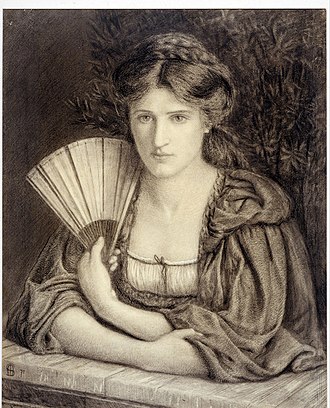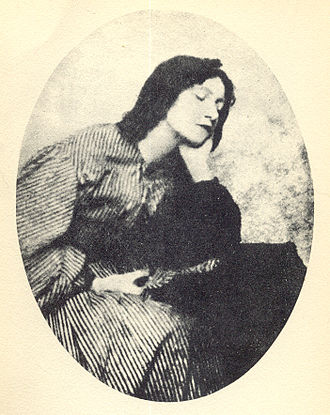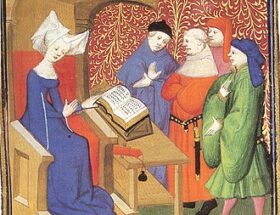
Early life
Marie Spartali was born on March 10, 1844, and was the eldest child of Michael Spartali, a wealthy merchant, principal of the firm Spartali & Co and Greek consul-general based in London, and Euphrosyne Varsini, the daughter of a Greek merchant from Genoa.
The family split time between their London home in Clapham Common and their country home on the Isle of Wight.
In the city, Michael Spartali was fond of lavish garden parties where he invited up and coming writers and artists. It was at one such event where Marie would first be introduced to the art world.
Connection to the Pre-Raphaelites
Known for their Greek heritage and beauty, Marie along with her cousins, Maria Zambaco and Aglaia Coronio, were known collectively among friends as “the Three Graces,” after the Charites of Greek mythology. Beauty aside, Marie was very tall, with an imposing figure and purposefully attracted much attention throughout her life.
In the house of the Greek businessman Alexander Constantine Ionides at Tulse Hill, in south London, Marie first met artist James Abbot McNeil Whistler and playwright Algernon Charles Swinburne. The meeting made quite the impression, for Swinburne was reported to have said: “She is so beautiful that I want to sit down and cry”.
In 1864, James Whistler introduced Marie to the Pre-Raphaelite artist Dante Gabriel Rossetti. Marie began sitting for him and when she expressed interest in learning to paint he referred her to Ford Madox Brown. Over the next five years the pair developed a close, almost familial, relationship.
Of his models, Ford Madox Brown said that Marie was “the most intellectual,” and maintained a deep respect for her work, chronicled in their correspondence.
By 1870, Marie had decided to pursue art professionally and with the help of her mentor made her first sale for 40 guineas.
Because of her close links to the Brotherhood Marie is often identified as part of the second generation of the movement. According to Henry James: “She inherited the traditions and the temper of the original PRs…but she has come into her heritage by virtue or natural relationship. She is a spontaneous, sincere, naive Pre-Raphaelite.”
There is, however, some academic debate as to whether this is entirely accurate. For example, Robert de la Sizeranne of Le Correspondant noted that this new generation of Pre-Raphaelites, Marie Stillman among them, had enough in common with the Symbolists to be considered one.
Marie could be considered a candidate for Symbolism because her figures “… have an immobility, a silence, a pose almost suspended, a slow hesitation in their rare movements, which make them resemble something like sleepwalkers.”
Dante Gabriel Rossetti himself credited Marie for her ability to infuse her figures with emotion, thereby elevating them to something more than mere images.
Marriage
In 1870, Marie met American journalist and painter William J. Stillman. The couple had previously posed for Rossetti in his famous Dante pictures, though it is not certain if that is how they first met. Interestingly, although her husband was an artist himself, Marie never sat for him as a model. The pair married in 1871 against her father’s wishes, causing a rift that would never fully heal.
As her husband was a foreign correspondent for The Times, the couple divided their time between London, Florence and later Rome (1889-1896).
The couple had three children of their own who were raised alongside William’s other three children from a previous marriage.
In 1873 both her young daughter, Euphrosyne and her sister Christina fell ill. Marie wrote to Ford Madox Brown that she was preoccupied with their health and felt “too weak to paint.” She later clarified that whenever she did work she found herself depicting her sister in a grim state. Because of this, Marie took some time off painting, however Ford Madox Brown always speculated that she stopped because of her husband’s jealousy over her successful career and continued relationship with himself.
Alongside her husband, Marie lived in Florence, Italy for a number of years. She took great inspiration from the city around her which can be seen most prominently in her subject matter. Being in the city of Dante Alighieri, she depicted numerous scenes from the Divine Comedy, focusing in particular on the romance between Dante and Beatrice.
Though separated from her peers, Marie maintained her correspondence with the Pre-Raphaelite Brotherhood and Rossetti in particular who shared her love of Dante.
Exhibitions
Marie exhibited at the Dudley Gallery in 1875, then at the Grosvenor Gallery and its successor the New Gallery at the Royal Academy, and at various galleries in the eastern USA, including the Centennial Exhibition in Philadelphia in 1876.
Marie also exhibited her work at the Palace of Fine Arts at the 1893 World’s Columbian Exposition in Chicago, Illinois.
Works
- The Lady Prays – Desire (1867, Lord Lloyd-Webber Collection)
- Mariana (c.1867–1869, Private collection)
- Portrait of a young woman (1868)
- Forgetfulness (1869, Private collection)
- La Pensierosa (1870, Chazen Museum of Art, University of Wisconsin–Madison)
- Self-Portrait (1871, Delaware Art Museum)
- Self-Portrait in Medieval Dress (1874)
- Gathering Orange Blossoms (1879, St. Lawrence University)
- The Meeting of Dante and Beatrice on All Saints’ Day (1881)
- Madonna Pietra degli Scrovigni (1884, Walker Art Gallery, Liverpool)
- Love’s Messenger (1885, Delaware Art Museum)
- A Florentine Lily (c.1885–1890, Private collection)
- The May Feast at the House of Folco Portinari, 1274 (1887)
- Dante at Verona (1888, Private collection)
- Upon a Day Came Sorrow unto Me (1888)
- A Florentine Lily (c.1885–1890)
- A Florentine Wedding Feast (1890)
- Messer Ansaldo showing Madonna Dionara his Enchanted Garden (1889)
- Convent Lily (1891)
- Cloister Lilies (1891, Ashmolean Museum, Oxford)
- Dante and Beatrice, Scene from the Vita Nuova (1891)
- Saint George (1892, Delaware Art Museum)
- How the Virgin Mary came to Brother Conrad of Offida and laid her Son in his Arms (1892, Wightwick Manor, National Trust, UK)
- A Rose from Armida’s Garden (1894)
- Love Sonnets (1894, Delaware Art Museum)
- Beatrice (1896, Delaware Art Museum)
- Portrait of Mrs W. St Clair Baddeley (1896)
- Beatrice (1898, Private collection)
- The Pilgrim Folk (1914, Delaware Art Museum)
Death
Marie Stillman died on 6 March 1927 in Ashburn Place in South Kensington, four days shy of her 83rd birthday. She was cremated at Brookwood Cemetery, near Woking, Surrey.


